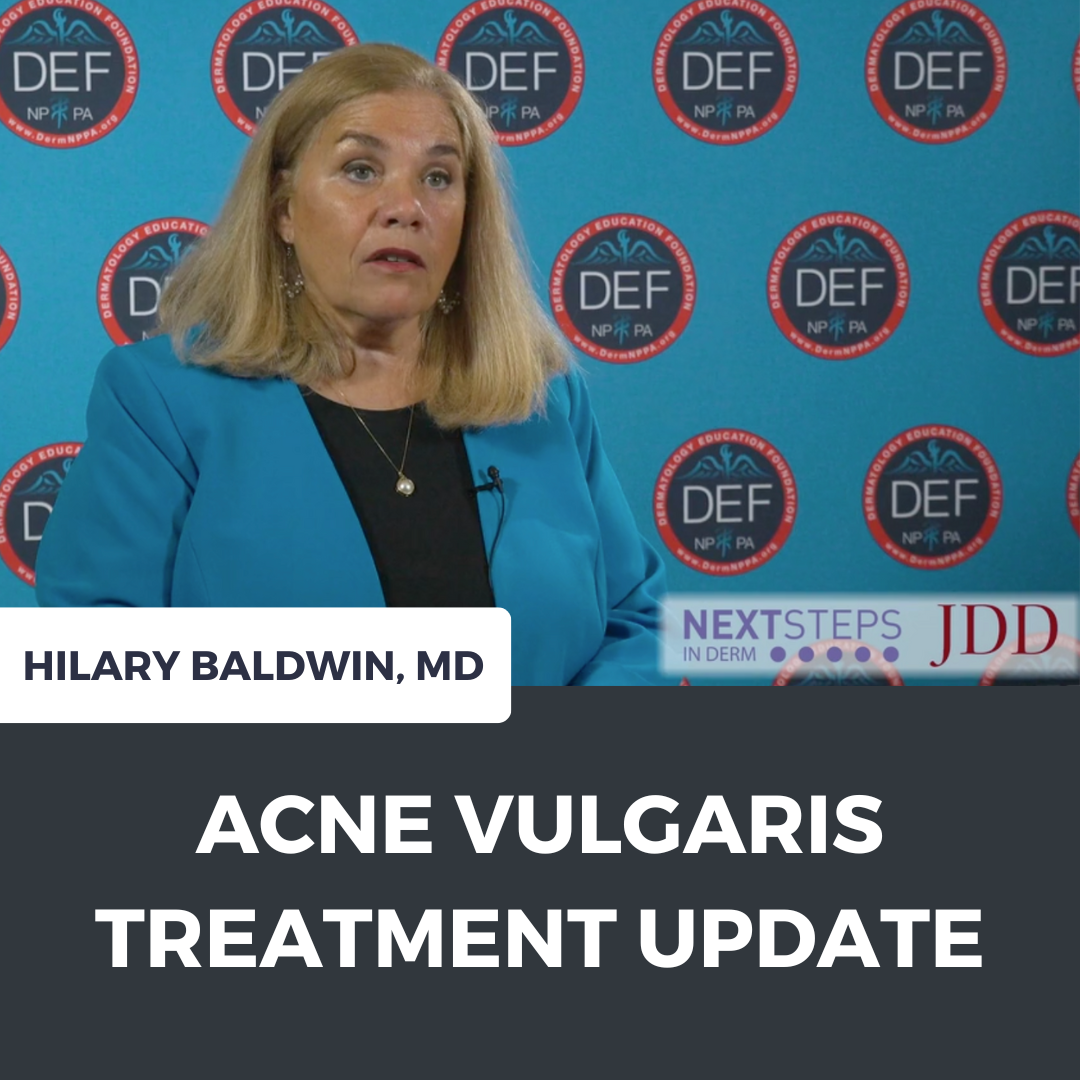Next Steps in Derm and the Journal of Drugs in Dermatology, in partnership with the Dermatology Education Foundation (DEF) and Physicians Resources, interviewed Dr. Hilary Baldwin, a board-certified dermatologist and medical director of the Acne Treatment & Research Center in Morristown, NJ and Brooklyn, NY. With the heavy acne tool box these days, how do you pick which medications to use? Dr. Baldwin shares her decision making process and why she prefers branded products. Don’t try to use the same recipe when treating acne – every patient is different! Watch Dr. Baldwin and learn tips from an expert on selecting acne medications for your patients.
Dr. Hilary Baldwin lectured on this topic at the DERM2022 NP/PA CME conference.
Further Reading
If you want to read more about acne vulgaris, check out the following articles published in the Journal of Drugs in Dermatology:
Patient Preferences for Acne Vulgaris Treatment and Barriers to Care: A Survey Study
The associated direct and indirect costs of acquiring acne vulgaris (acne) treatment from a clinician may prohibit some patients from doing so. Barriers to care may also influence patient preferences for treatment, and while both over-the-counter (OTC) and prescription acne treatments are efficacious, preferences for OTC or prescription acne medications are not well established.
We recruited 529 adult subjects from the United States through Amazon Mechanical Turk (MTurk), and subjects were surveyed about acne, their acne treatment preferences, and any barriers to care. A total of 450 subjects passed the attention check and were included in the analysis.
Of respondents who had tried both OTC and prescription treatments (n=223), more respondents reported that they preferred prescription treatments (130/223, 58.3%), compared with OTC treatments (64/223, 28.7%); or no preference (29/223, 13.0%; P=0.00001). Almost half of all respondents also stated that they experienced barriers to accessing medical care for acne treatment (192/450 42.7%); cost and transportation were the top 2 factors. Considering how common barriers are, and their everchanging nature, some patients may benefit from a discussion of alternative non-prescription acne treatments, serving as a bridge to therapy or while patients are unable to reach a medical provider.
Hormonal Therapies in the Management of Acne Vulgaris
Acne vulgaris is a multifactorial chronic disorder of the pilosebaceous unit. Established treatments include topical retinoids, antibiotics in mild cases, and oral antibiotics and isotretinoin in moderate to severe cases. Anti-androgens and other hormonal therapies constitute another group of drugs in the armamentarium of acne management. These can be used in patients who do not respond to the aforementioned treatments or when other systemic drugs cannot be tolerated. Recent approval of topical androgen receptor blocker is an additional armamentarium for the management of acne. Considering limited systemic exposure and good efficacy, it has potential for wide usage in patients with acne. In this article, we critically review currently available hormonal treatment options based on published literature search of an electronic database (MEDLINE/PubMed) performed through June 2021.
Acne Vulgaris: The Majority of Patients Do Not Achieve Success According to FDA Guidance
ABSTRACT
Background: The Food and Drug Administration (FDA) recommends grading Acne vulgaris via an Investigator’s Global Assessment (IGA) scale and assessing treatment as either success or failure, with success defined as clear (grade 0) or almost clear (grade 1) with at least a two-grade improvement in acne severity from baseline.
Objective: To determine the likelihood of achieving real world treatment success in patients with acne according to FDA guidance.
Methods: We calculated estimated appropriates to obtain the IGA 0/1 (clear or almost clear rate) for many of the oral and topical medications. We also used the National Ambulatory Medical Care Survey (NAMCS) data to determine the number of medications prescribed for outpatient visits when isotretinoin was prescribed or when isotretinoin was not prescribed and the one and only diagnosis was acne.
Results: Isotretinoin had the highest IGA 0/1 at 87%. None of the other medications had an IGA 0/1 > 40%. Of all outpatient acne visits, only 6% receive isotretinoin. When excluding isotretinoin visits, 71% of patients received ≤ 2 medications.
Limitations: The majority of the acne medication studies lasted 12 weeks, however, it can take 6 months or longer to get the maximum effect. None of the studies combined topical and oral medications.
Conclusions: The majority of acne patients are not likely to achieve success according to FDA guidance. We propose that the FDA guidance may be too rigorous. An alternative hypothesis is that most acne patients are undertreated.
Did you enjoy this video interview? Find more here.

